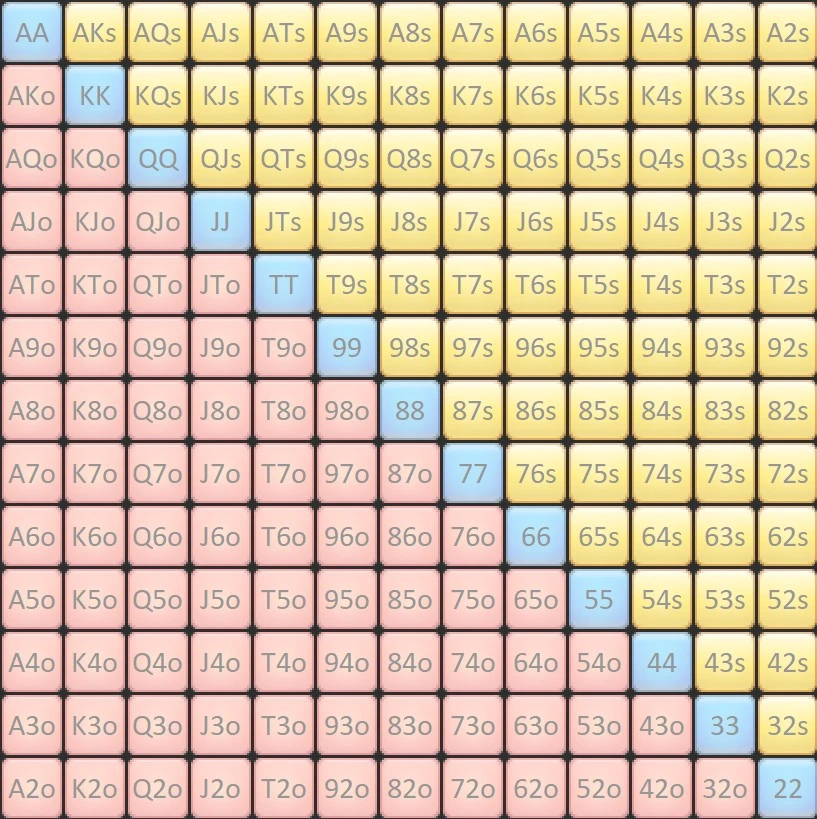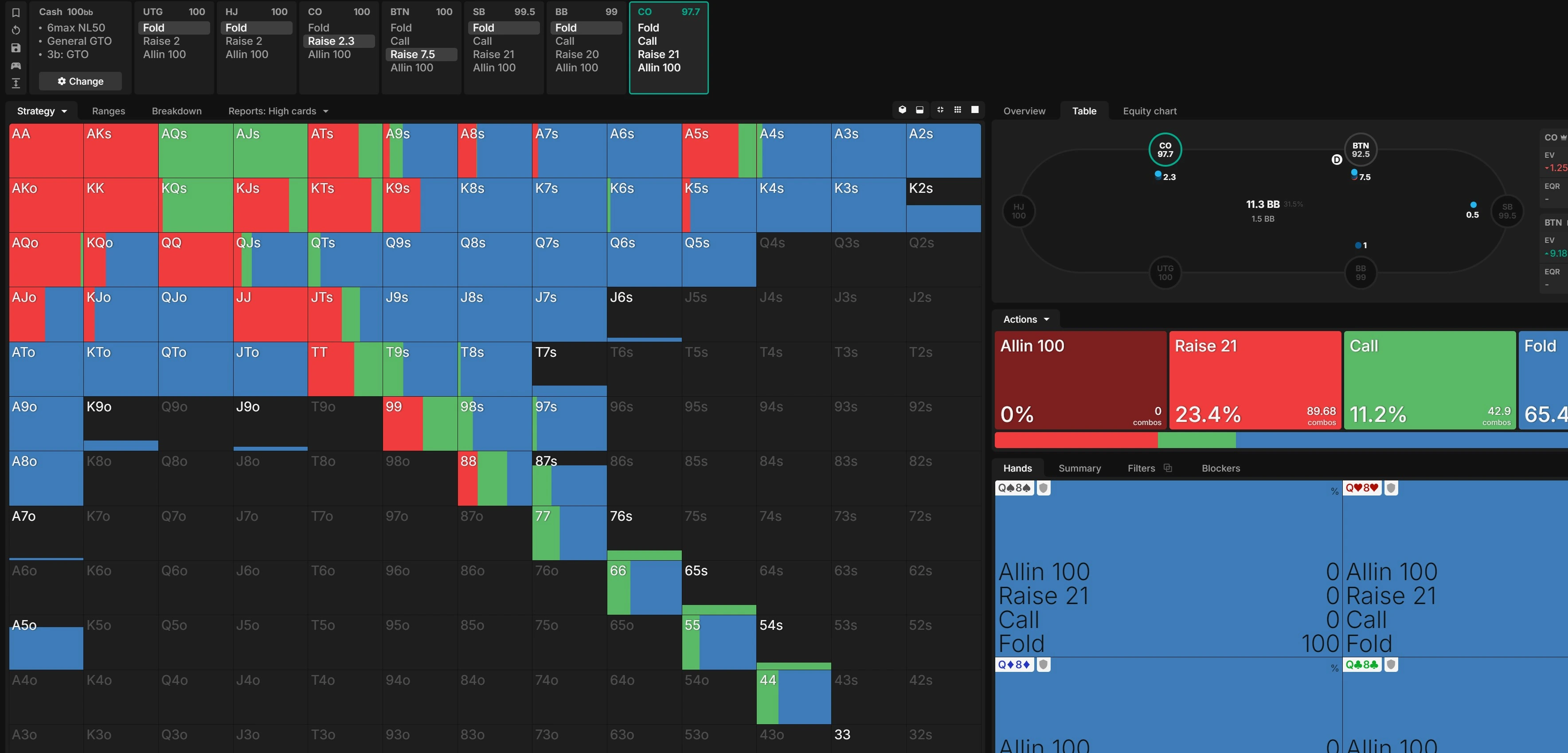Preflop Strategy to Master Charts, Bet Sizes & Exploits

Apr 14, 2025
•
2 min read
A solid understanding of preflop play is crucial for any player. Master preflop and you’re in the game.
- Phil Ivey
In the previous chapter, we discussed the power of poker tools and the importance of selecting the right ones for your skill level.
Now, we’ll delve into the fundamentals of preflop strategy, covering unexploitable and exploitative theories, preflop charts, and bet sizing.
Ready to master preflop strategy? Let’s begin!
GTO Poker Charts
Perhaps the most amazing thing about learning poker today is the proliferation of poker solvers, those computer programs that crunch so many numbers we can approximate unexploitable poker.
Preflop solvers use generalizations to model real world post flop scenarios, then pit preflop ranges against each other until one can no longer gain an edge on the other. The result gives us a glimpse into “perfect play.” That peek provides preflop charts and “optimal” sizes.
Some of what preflop solves reveal, professionals already knew. Primarily, that open limping doesn’t happen in Nash equilibrium solutions, and that RFI, or raise-first-in ranges, open up as we move from UTG towards the button.
Preflop charts are the most efficient and absolute quickest way to improve your poker game.
- Doug Polk
These GTO preflop solves offer a great entry point for beginners to get their preflop strategy dialed in right from the get-go. If you’re ready to learn the quickest way to play bulletproof preflop, keep reading!
How To Use Preflop Charts
First, we must know how to read a preflop chart:
- The square layout covers all possible starting hole-card combinations.
- The diagonal down the middle contains pocket pairs.
- The top has suited combos and bottom has off-suit.
Four combos of suited cards exist (one for each suit) and twelve of their off-suit counterparts. There are six ways to make pocket pairs. They add up to 1326 unique starting combinations.

GTO Wizard’s free version might be all your preflop strategy needs at first. These charts lay out the first possible move we can make, that is enter the pot. As stated, open limping does not happen.
Of course, calling first in is an option, but the complexity of balancing calling and raising ranges proves too much, even for computers.
RFI, or Raise First In
So, the first preflop charts people tend to look at tell us whether to fold or open raise. For positions after UTG, excluding the blinds, the charts assume action folds to us. Some top portion of our range open raises and the rest folds.
The visual representation is rather obvious, but all charts will have some key to decode actions based on colors used. This happens down the line as more decisions, like calling or using multiple bet sizes occur in a model’s output.
For example, when action gets folded to SB, GTO preflop strategy does include flatting and continuing from there.
Blind Defense
When we’re in the blinds and facing action, we must learn how to defend. In general, SB prefers to re-raise or fold against an open raise whereas BB has a more robust flatting range. SB does not close the action like BB and worries about another entrant in the hand.
The attempt here is not to win, but to lose less then outright folding. If you fold every time, you’re big-blind, your win-rate there becomes -100bb/100 hands. In the small-blind, it’d be -50/100. That’s the benchmark we begin with.
Bet Sizing Before the Flop
After reviewing open-raise (RFI) charts and blind defense strategies, let's explore additional preflop scenarios—specifically, situations where we raise and face a re-raise or initiate the re-raising ourselves.
To recap, the blinds represent the initial forced bets that create an incentive for players to contest the pot with a variety of hands, not just premium ones like pocket Aces. The big blind is referred to as the "1bet."
An open raise, or RFI, is considered the "2bet" since it's the second bet entering the pot. Consequently, a re-raise after an open is known as a 3bet.
Once you’ve mastered the basics of open-raising and defending against open-raises, the next step in preflop strategy is understanding what hands to re-raise with and how to respond to re-raises. Unsurprisingly, our strongest hands typically aim to maximize the number of bets in the pot.

The complexity deepens when considering position-specific ranges and the varied options available, such as 4-betting or flat-calling in response to a 3-bet. At this stage, it becomes clear that GTO charts and the preflop strategies they represent require significant memorization and pattern recognition.
Tips to Memorize Preflop Poker Charts
Here are four practical tips to help you effectively learn and apply preflop charts:
- Simplify your strategy: When faced with charts showing hands that could go either way, stick to the most common move as your 100% default preflop strategy. Don’t worry—you won’t lose money or get exploited by doing this.
- Save your ranges: Use a range visualizer tool or app to input and save these ranges. That’s exactly what the software is for, and it’ll come in handy later for analysis. Plus, filling in the ranges helps lock their patterns into your memory.
- Test your memory: Practice by filling out blank range charts from memory. While you can keep the charts open as a reference during play, the less you rely on them, the sharper and more focused you’ll become.
- Train with simulations: Use range training software that mimics preflop actions and challenges you to respond as if seated at a real poker table. Some tools may cost money, but the investment is absolutely worth it.
Above all, after you’ve committed a bunch of ranges to memory, re-read the section right below.
Why No Chart is Perfect
Memorizing charts might seem like a shortcut to mastering preflop strategy, but it’s far from the truth. GTO charts can make you unexploitable preflop and reveal how regs play, but understanding the theory behind solver outputs is crucial for profitable decisions.
Most charts assume a specific rake structure and 100 big-blind stacks, but rake and effective stack sizes greatly impact starting ranges. High rake reduces rewards, encouraging tighter play. Shallow stacks increase the likelihood of going all-in, favoring hands like top-pair or A-high. Deep stacks, on the other hand, enhance the value of speculative hands like suited connectors while influencing 3-bet and 4-bet strategies.
For example, at 1,000 big blinds deep, frequent 5-bets or 6-bets become unrealistic, as they’d clearly signal premium hands.
Explore GTO charts across various stack sizes to deepen your understanding. For now, rely on these principles to guide your preflop strategy.
Preflop Bet Sizing – Opening the Pot
For the sake of not being the odd one out, notice the most used opening size by regs in your player-pool and just open with that size from all positions.
The edges from using other sizes or worrying about opening larger from CO and BTN than from UTG are so small you should only consider them when you’re done learning how to obliterate fish and dominate bad regs.
If people in your pool tend to open 2.25bb, then that’s your opening size. If that seems too specific, that’s because you’re not using a multi-tabling tool that has preset bet sizes. Professionals let software like Jurojin handle these functions.

Note that SB opens tend to be larger, around an even 3bb.
We’ll cover when to deviate from these norms a bit down the line when discussing the key to profit: exploitation.
Bet Sizing for 3bets and 4bets
When adjusting your bet sizes preflop, consider these general guidelines:
- In position (IP), 3bet around 3.5x the open raise.
- Out of position (OOP), 3bet around 5.5x the open raise.
- In position (IP), 4bet approximately 2.2x the 3bet size.
- Out of position (OOP), 4bet approximately 2.7x the 3bet size.
These sizes serve as a baseline for optimal play and can be adjusted depending on stack depths, opponent tendencies, and specific table dynamics.
Make More Money from Your Opponents’ Mistakes
Regs often use the same charts as you, but fish are easy to exploit—just adjust your bet sizing.
For example, when a fish is in the big blind, don’t stick to a standard 2.25bb open. Raise to 4bb or 5bb and push further until they start calling with a tighter range, as worse odds force them to adjust.
Fish also play too many hands, making them vulnerable to 3-bets. They’ll either fold too much or call too wide, giving you immediate profits or an edge post-flop. With position on a fish, widen your opening range and see more flops—they’ll make more mistakes, especially with deeper stacks.
Exploitative strategy is about adapting your GTO approach to capitalize on their deviations. Since fish don’t use GTO charts, their tendencies will be obvious if you track their stats with a HUD. Look for patterns like overfolding to 3-bets or calling too wide out of position to adjust your strategy effectively.
Conclusion
Always remember, all hands start preflop. Developing a solid preflop strategy is essential if you want to make a profit.
Fortunately, you can play like a pro from the beginning by using simplified GTO preflop charts. They tell you exactly how to act at any preflop node. There’s quite a lot of them and you can commit them to memory by saving them in your software.
Exploit fish by increasing your open sizing as well as your range. They won’t adapt to the worse odds you’re offering, and they will make more post-flop mistakes, giving you the edge.
Thank you for reading. Stay tuned for more tips and strategies!
ZOOM IN
The following links are recommended resources related to this section’s theme. Don’t stay in doubt--dive in! 🔔
- Charts: Learn more about preflop chart uses.
- Ranges: Learn how to calculate & use poker ranges.
- Position: You may want to check this positional guide.
- Sizing: Discover more about preflop bet-sizes.
- Pot Odds: Learn how to calculate pot odds for online poker.
- Discord Community: Join the coolest poker community, don’t be shy! Use it to ask questions and interact with other poker enthusiasts and professionals.